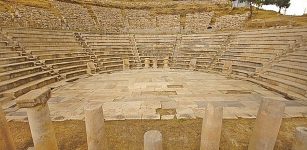Evidence Of Cosmic Catastrophe 12,800 Years Ago – Earth Collided With Fragments Of A Comet
AncientPages.com - It would seem that all ancient myths about a great flood are true after all.
About 12,800 years ago, the Earth emerged from another ice age. Things were warming up, and the glaciers had retreated. Suddenly, the sky was lit with fireballs and shock waves followed.
Scientists have found evidence that a cosmic catastrophe changed our planet’s climate 12,800 years ago.
Fires rushed across the landscape, and dust clogged the sky, cutting off the sunlight. As the climate rapidly cooled, plants died, food sources were snuffed out, and the glaciers advanced again. Ocean currents shifted, setting the climate into a colder, almost "ice age" state that lasted an additional thousand years.
Finally, the climate began to warm again, and people again emerged into a world with fewer large animals and a human culture in North America that left behind completely different kinds of spear points.
See also:
A Great Flood Destroyed The Mysterious Ancient City Of Petra – Evidence Has Been Found
Evidence Of Legendary Ancient Great Flood In China May Re-Write History
Scientists from the University of Kansas have published the results of their massive study in the Journal of Geology. The research is based on measurements made at more than 170 different sites across the world.
According to researchers, data suggests the disaster was touched off when Earth collided with fragments of a disintegrating comet that was roughly 62 miles in diameter—the remnants of which persist within our solar system to this day.
"The hypothesis is that a large comet fragmented and the chunks impacted the Earth, causing this disaster," KU Emeritus Professor of Physics & Astronomy Adrian Melott said.
Credit: University of Kansas
"A number of different chemical signatures—carbon dioxide, nitrate, ammonia and others—all seem to indicate that an astonishing 10 percent of the Earth's land surface, or about 10 million square kilometers, was consumed by fires."
According to Melott, analysis of pollen suggests pine forests were probably burned off to be replaced by poplar, which is a species that colonizes cleared areas.
Indeed, the authors posit the cosmic impact could have touched off the Younger Dryas cool episode, biomass burning, late Pleistocene extinctions of larger species and "human cultural shifts and population declines."
"Computations suggest that the impact would have depleted the ozone layer, causing increases in skin cancer and other negative health effects," Melott said. "The impact hypothesis is still a hypothesis, but this study provides a massive amount of evidence, which we argue can only be all explained by a major cosmic impact."
AncientPages.com
Expand for references





















